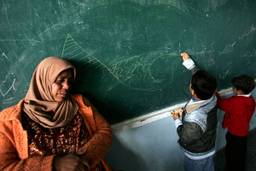
In his first visit to the White House on May 23, Israeli Prime Minister Ehud Olmert told President Bush that Israel will “devote six to nine months to find a Palestinian partner” before it pursues the unilateral “Convergence Plan.” It was an empty promise. Olmert knows that given the reality in the West Bank and Gaza Strip, the probability of returning to the negotiation table is close to zero.
Since the ruling Fatah party lost the democratic elections to the Islamist party Hamas, much has changed in the Occupied Territories. Following Hamas’s electoral victory, Olmert asked foreign leaders to boycott the new Palestinian Authority (PA) until it complied with three conditions: 1) disarm Izzeddin al-Qassam and other paramilitary groups; 2) annul Hamas’ charter, which calls for the destruction of Israel; and 3) accept the agreements and obligations that the Palestinian Authority took upon itself when the Fatah party was in control.
Olmert’s conditions are reasonable. And given Palestinian Prime Minister Ismail Hania’s recent statement that if Israel withdraws to the 1967 borders Hamas will be willing to sign a peace agreement based on an extended hudnah (truce), the first two conditions could easily become part of future negotiations rather than a condition for negotiations. Olmert’s third demand, however, puts Israel in a thorny spot. After all, Israel, not the Palestinians, has been using the separation barrier in the past three years to execute a unilateral plan that contravenes all previous agreements. Thus, according to Olmert’s logic, the international community would also need to boycott Israel in order to remain consistent.
Nonetheless, following U.S. pressure, the three other members of the Quartet – the United Nations, the European Union and Russia – agreed to follow the general thrust of Olmert’s demands, and have cut off most of the foreign aid to the Palestinian Authority.
Even before the foreign aid was cut, 64 percent of the Palestinian inhabitants were living under the international poverty line of $2.20 a day, while the World Bank reported that acute malnutrition affected 9 percent of Palestinian children. Since the aid amounts to almost one-third of the per capita gross national income in the West Bank and Gaza, the cuts could eventually lead to a famine.
Since February, when the foreign aid was cut, the Palestinian Authority has been unable to pay salaries to its 160,000 employees. These workers provide direct livelihood to over one million people (almost a third of the population), and if their salaries are not paid for a few more months the Palestinian economy will totally collapse. Both Israel and the United States are now thinking of ways to alleviate the dire situation – after all, no wants to be blamed for producing a famine. Together they have adopted a scheme that could be called the “Somalia Plan.”
The idea is to transfer salaries directly to the bank accounts of those 90,000 PA workers who are employed by civil institutions like the education and health ministries. The remaining 70,000 Palestinians who work for one of numerous security apparatuses in the Occupied Territories will not receive salaries. This will keep the economy just above the famine level, leaving 70,000 armed men with nothing but frustration and anger.
Under such conditions, a struggle is sure to break out among the different Palestinian warlords over the scant resources in the Occupied Territories. Already, Ha’aretz has reported that dozens of bombs have been laid near houses or cars of senior Hamas officials and officers in the last few weeks, while homes and cars of Fatah senior officials and Preventive Security officers have also been booby-trapped. In some cases the bombs went off, causing injuries and damage.
If the existing skirmishes among the different factions develop into full-blown battle, it may very well be that certain segments of the Palestinian population will go hungry. Yet, it’s the warlords or faction leaders, rather than Israel or the United States, who will be blamed for the human catastrophe. We are, in other words, witnessing Somalia in the making.
Members of the European Union have expressed “serious concern” about the deterioration in the humanitarian, economic and financial situation in the Gaza Strip and West Bank. But even though they have pledged to resume payments to the Palestinians, E.U. foreign policy chief Javier Solana hinted to Ha’aretz that resistance from the U.S. Congress might make it impossible to transfer the funds.
So it is not only that Israel and the United States are uninterested in abating the violent clashes among Palestinians. They do not seem to care that a civil war in the Occupied Territories will both engender immense suffering and destabilize the region for decades. In many ways, their policies are precipitating this – not coincidentally, but as part of the very logic informing the perpetual war on terror.







